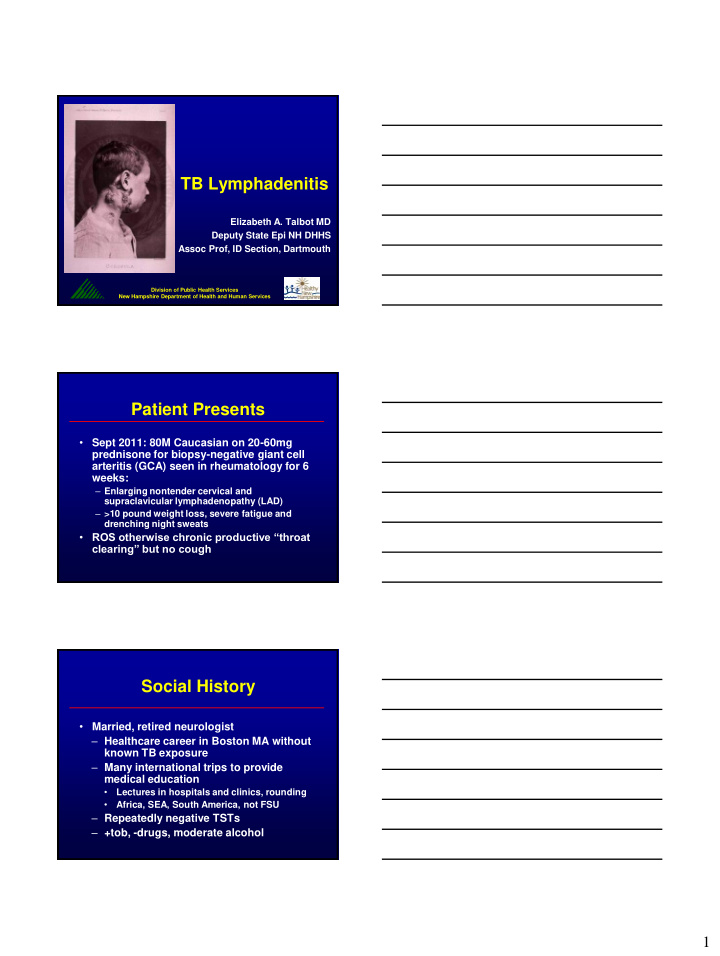



TB Lymphadenitis Elizabeth A. Talbot MD Deputy State Epi NH DHHS Assoc Prof, ID Section, Dartmouth Division of Public Health Services New Hampshire Department of Health and Human Services Patient Presents • Sept 2011: 80M Caucasian on 20-60mg prednisone for biopsy-negative giant cell arteritis (GCA) seen in rheumatology for 6 weeks: – Enlarging nontender cervical and supraclavicular lymphadenopathy (LAD) – >10 pound weight loss, severe fatigue and drenching night sweats • ROS otherwise chronic productive “throat clearing” but no cough Social History • Married, retired neurologist – Healthcare career in Boston MA without known TB exposure – Many international trips to provide medical education • Lectures in hospitals and clinics, rounding • Africa, SEA, South America, not FSU – Repeatedly negative TSTs – +tob, -drugs, moderate alcohol 1
Rheumatology Evaluation • PE: afebrile, anxious-appearing regarding differential diagnosis – Confirmed weight loss – Nontender, mobile anterior cervical and supraclavicular LAD – Lungs CTA • Labs WBC normal, ESR 100, LFTs normal and HIV negative CXR: wide mediastinum and possible small R apical lung nodule CT scan: extensive necrotic LAD in supraclavicular superior mediastinal region with <1cm R apical lung nodule 2
Differential and Investigation • Differential diagnosis: malignancy vs sarcoid vs mycobacterial disease – QFTG strong positive • Excisional biopsy of R cervical node done – Routine, fungal and AFB smear negative – Mycobacterial culture pending – Flow cytology showed no B or T cell clonality – Path showed necrotizing granulomas Empiric TB Treatment? • MD advocated based on – Pathology – Travel – Consistent symptoms • Patient declined • Continued fever, WL, fatigue – Excisional site healed well • AFB culture pos day 23 – Probe positive for MTBC • Begun on INH, RMP, PZA, EMB TB Lymphadenopathy Epidemiology • 20% of all TB in the US is extrapulmonary (EP) and TB LAD represents 30% of EPTB – 8.5% of all US TB is LAD • Represents reactivation at site seeded hematogenously during primary TB • Epidemiology – Peak age from children, to 30-40 yo – F:M 1.4:1 – HIV-infected – Asians: consumptions, genetics, BCG effect? 3
Typical Presentation • Most common is isolated chronic, nontender LAD • Firm discrete mass or matted nodes fixed to surrounding structures – Overlying skin may be indurated – Uncommon: fluctuance, draining sinus • Cervical LAD is most common site of TB LAD • Unilateral mass in ant or post cervical triangles – Bilateral disease is uncommon – Multiple nodes may be involved • Differential diagnosis NTM, other infections, sarcoid, neoplasm • FNA is safer but less sensitive than biopsy – ~50% sensitive and 100% specific – Combining both cytlogy and microbiology can increase sensitivity to 91% • NAATs underutilized • Automated NAAT (Xpert) active study 4
First Complication • 2 weeks into 4-drug therapy – Fatigue and anorexia worse • Sleeping 18 hours a day! – Weight loss and night sweats continue • Reports to ED where found in new afib • Admitted and transthoracic echocardiogram shows mod pericardial effusion with RA inversion and impaired RV filling but no tamponade • Drained 500ml AFB smear negative fluid • Differential pericardial TB vs IRIS? Paradoxical Upgrading Reactions • Enlarging or new LAD >10 days into therapy from released mycobacterial antigens • Relatively common: ~12%* mixed population and 20-23% of HIV-neg** • Median onset 46d (range 21-139) • Resolution nearly 4 months • Controversial role of steroids • Role of excision vs. aspiration *Blaikley et al. INT J TUBERC LUNG DIS 15(3):375 – 378 **Fontanilla et al. CID 2011 53: 555 Effectiveness of Corticosteroids in TB Pericarditis • Systematic review of 4 RCTS showed nonstatistically significant survival benefit – 411 HIV-neg: RR 0.65, 95%CI 0.36 – 1.16; p=0.14 – 58 HIV-pos: RR 0.50, 95%CI 0.19 – 1.28; p=0.15 • No effect on re-accumulation of effusion or progression to constrictive pericarditis Ntsekhe et al, Q J Med 2003; 96: 593. 5
Second Complication • 4 weeks into 4-drug therapy – Faint puritic maculopapular rash over chest and back – Fatigue and anorexia worse • Sleeping 18 hours a day! – Weight loss and night sweats continue • Isolate confirmed as fully susceptible • Discontinued INH with some improvement in fatigue and rash • EMB, RMP, PZA Today • Asymptomatic, on continuation EMB+RMP • Six months intended – Review of 8 papers of treatment of TB LAD showed no difference between 6 and 9 months relapse rates* • Remaining questions *van Loenhout-Rooyackers et al. Eur Respir J 2000; 15: 192-195. Engraving by André Du Laurens (1558-1609), showing King Henry IV of France touching scrofula sufferers 6
More recommend